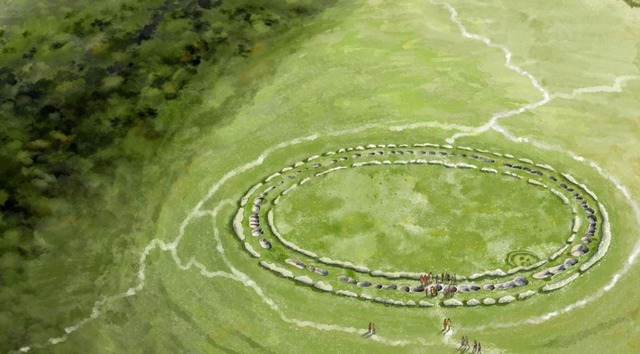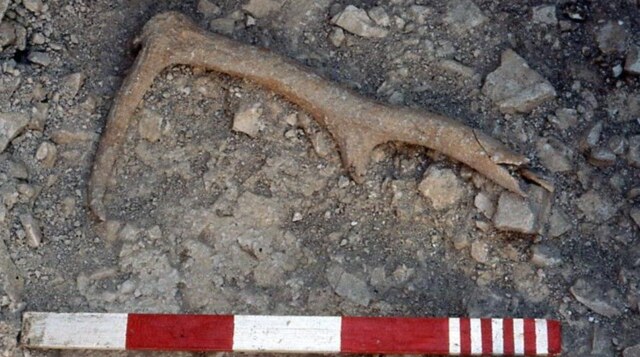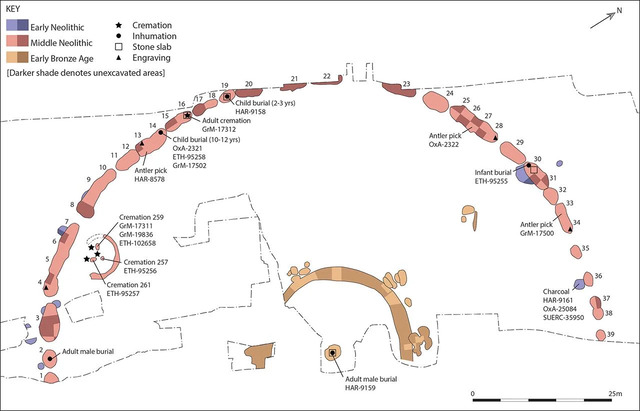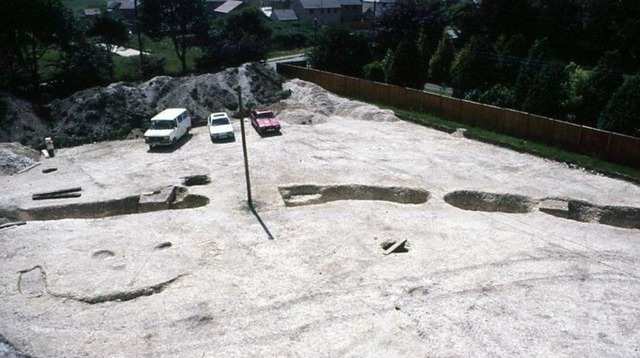Hidden beneath the rolling hills of Dorset, England, lies a prehistoric discovery that could rewrite the history of Britain’s ancient monuments. Flagstones, a long-forgotten burial site, has been re-dated to 3200 BCE—making it potentially five centuries older than the iconic Stonehenge. This revelation, uncovered through advanced radiocarbon dating, challenges everything we thought we knew about early Neolithic Britain. As archaeologists uncover the secrets of this ancient site, we are left wondering: could Flagstones have inspired the creation of Stonehenge, or does it reveal a much older cultural timeline than we ever imagined?
Revelation of Flagstones
Flagstones, located near Dorchester in Dorset, was first discovered during road construction in the 1980s. Beneath the surface of the earth, archaeologists uncovered the remains of an ancient site—a perfectly circular ditch formation, measuring 100 meters across. Initially, experts believed the site dated to around 3000 BCE, placing it within the same period as the famous Stonehenge. However, advanced radiocarbon dating has revealed a much earlier origin, possibly as far back as 3200 BCE, making Flagstones the oldest known large circular enclosure in Britain. The excavation of Flagstones provides a fresh lens through which we can view prehistoric Britain, offering insights into early human life, burial practices, and societal organization.

Video
Watch the video about the ancient Dorset burial site and how it might rewrite Stonehenge’s history.
Radiocarbon Dating and the New Timeline
The re-dating of Flagstones was carried out by a team of archaeologists from the University of Exeter and Historic England, who employed advanced radiocarbon analysis to determine the true age of the site. Previously thought to be contemporaneous with Stonehenge, which was first erected around 3000 BCE, the new findings show that Flagstones predates its more famous counterpart by about 200 years. This discovery was made possible through the meticulous examination of charcoal, red deer antlers, and human remains found at the site. The dating process revealed that the digging of pits began as early as 3650 BCE, with the circular enclosure itself being constructed around 3200 BCE.

This breakthrough not only pushes back the timeline of Flagstones but also challenges the previously held assumptions about the development of ceremonial and burial sites in Britain. As the first large-scale circular structure discovered, Flagstones holds immense importance in understanding the progression of Neolithic architecture and social practices.
The Similarities to Stonehenge
One of the most intriguing aspects of the Flagstones discovery is its striking similarities to Stonehenge, particularly in the architectural layout. Flagstones is a perfectly circular ditched enclosure, a design also seen in the first phase of Stonehenge, dated to around 2900 BCE. This similarity raises important questions: Could Flagstones have served as a prototype for later monuments like Stonehenge? Or does the new dating suggest that Stonehenge’s history might need to be revised?

Susan Greaney, a specialist in Neolithic and Bronze Age monuments from the University of Exeter, suggests that Flagstones could indeed be the precursor to later henge sites like Stonehenge. She emphasizes that Flagstones exhibits characteristics of earlier “causewayed enclosures,” but it also shares elements with later henge monuments. The revised chronology now places Flagstones as a crucial transitional monument that may have influenced the development of monumental sites in the region, including Stonehenge.
The Excavation of Flagstones

The excavation of Flagstones has uncovered an array of fascinating findings, providing a deeper understanding of the site’s role in ancient rituals and society. Among the discoveries, archaeologists found multiple burials and cremations within the circular enclosure. Four burials, including the cremated remains of one adult and three children, were placed in the site’s pits, suggesting that this was a sacred area for ritualistic practices. In addition to these early burials, a later burial of a young adult male was found under a large sarsen stone at the center of the enclosure, dating to approximately 1000 years after the site’s initial use.
The discovery of these remains provides valuable insights into the burial customs of the Neolithic people of Britain. The cremations and the careful positioning of the bodies point to the importance of ritual in early society, and the continued use of the site over centuries highlights its ongoing cultural and spiritual significance. The presence of a young adult male under the sarsen stone also suggests that Flagstones was still a place of importance long after its initial construction.
The Role of Flagstones in Prehistoric Rituals
The circular enclosures like Flagstones were not just architectural feats; they were deeply tied to religious and ceremonial practices. In prehistoric Britain, these sites were often used for gatherings, feasts, and rituals that played a central role in the social and spiritual life of the community. The construction of such monumental sites would have required significant communal effort, indicating a highly organized and cooperative society.
Flagstones, with its perfectly circular design and ceremonial functions, likely served as a focal point for early Neolithic communities in southern Britain. The site’s strategic location, its alignment with celestial events, and its connections to other prehistoric monuments suggest that it was not just a burial site but a place of great symbolic importance. It may have served as a prototype for later henges like Stonehenge, whose alignment and purpose continue to captivate archaeologists and historians alike.

Flagstones and the Broader Neolithic Context
Flagstones does not exist in isolation; it is part of a broader Neolithic tradition of monumental architecture and burial practices that spread across the British Isles. Connections have been made between Flagstones and other significant prehistoric sites, such as Llandegai in Gwynedd, and these links provide further evidence of the widespread influence of such monumental enclosures during this period.
The study of Flagstones helps scholars better understand the changes in ceremonial and funeral monuments throughout Neolithic Britain. This discovery adds a new dimension to the existing body of knowledge about prehistoric communities and their spiritual practices, which were deeply entwined with their relationship to the land and the cosmos.
Video
Watch the video about the mysterious stone structure that is older than Stonehenge.
Conclusion
The re-dating of Flagstones is a monumental discovery that challenges previous assumptions about the timeline of Neolithic Britain. It sheds new light on the origins of Britain’s most iconic monuments, including Stonehenge, and may suggest that the famous stone circle was influenced by earlier sites like Flagstones. As archaeologists continue to uncover the mysteries of Flagstones and similar sites, we are presented with a deeper understanding of the ancient people who built these monumental structures. The discovery of Flagstones marks a turning point in how we view prehistoric rituals, burial customs, and the cultural connections that shaped early human societies in Britain.



